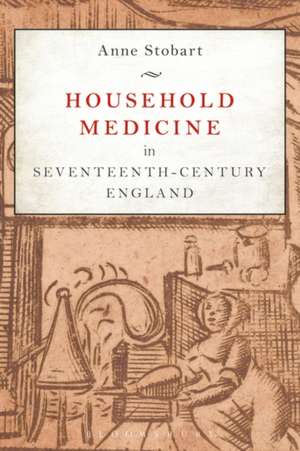Household Medicine in Seventeenth-Century England
Autor Dr Anne Stobarten Limba Engleză Paperback – 7 sep 2016
| Toate formatele și edițiile | Preț | Express |
|---|---|---|
| Paperback (1) | 181.32 lei 43-57 zile | |
| Bloomsbury Publishing – 7 sep 2016 | 181.32 lei 43-57 zile | |
| Hardback (1) | 713.29 lei 43-57 zile | |
| Bloomsbury Publishing – 7 sep 2016 | 713.29 lei 43-57 zile |
Preț: 181.32 lei
Preț vechi: 208.46 lei
-13% Nou
Puncte Express: 272
Preț estimativ în valută:
34.71€ • 37.71$ • 29.17£
34.71€ • 37.71$ • 29.17£
Carte tipărită la comandă
Livrare economică 21 aprilie-05 mai
Preluare comenzi: 021 569.72.76
Specificații
ISBN-13: 9781472580344
ISBN-10: 1472580346
Pagini: 304
Ilustrații: 12 bw illus
Dimensiuni: 156 x 234 x 18 mm
Greutate: 0.48 kg
Editura: Bloomsbury Publishing
Colecția Bloomsbury Academic
Locul publicării:London, United Kingdom
ISBN-10: 1472580346
Pagini: 304
Ilustrații: 12 bw illus
Dimensiuni: 156 x 234 x 18 mm
Greutate: 0.48 kg
Editura: Bloomsbury Publishing
Colecția Bloomsbury Academic
Locul publicării:London, United Kingdom
Caracteristici
Unlike existing studies, this book considers the practice of early-modern medicine by lay people, rather than theories subscribed to by professionals
Notă biografică
Anne Stobart is Honorary Research Fellow at the University of Exeter, UK and former Director of Programmes in Complementary Health Sciences and Programme Leader of the BSc in Herbal Medicine at Middlesex University, UK. She is a member of the Advisory Board for the Journal of Herbal Medicine and chairs the Herbal History Research Network. Anne writes for the Recipes Hypotheses blog which brings together an international group of scholars writing on the history of recipes. She is a founder of the Holt Wood project on sustainable cultivation and harvest of medicinal trees and shrubs.
Cuprins
Table of ContentsIntroduction: Household Health Care MattersSection 1: Information1. 'The danger is over': News About the Sick2. Medicines or Remedies: Recipes for Health and IllnessSection 2: Resources3. Early Modern Spending on Health Care4. Animal, Vegetable and Mineral: Medicinal Ingredients5. 'For to make the ointment': Kitchen PhysickSection 3: Practice 6. Therapeutics in the Family7. 'I troble noe body with my Complaints': Chronic DisordersConclusionAppendix of Household AccountsGlossary of IngredientsBibliographyIndex
Recenzii
Stobart's sources are . exceptionally well chosen, and the author makes very good use of the letters, pieces of advice, recipe books, descriptions of gifts sent and received, prescriptive instruction, and household accounts that have survived in each family's papers.
Stobart, a leading scholar in the history of herbal medicine, has produced an excellent survey of how some early modern households managed their health on a day-to-day basis. Specifically, she seeks to question not only the prevailing assumption that self-help was the primary source of health care, but also what self-help actually meant in 17th-century England. To address this, the author divides household medicine into three themes that showcase the richness of her archival sources, namely, information (letters and recipe collections), resources (accounts, expense, equipment), and practice (treatment of children and chronic cases). This allows Stobart to convincingly argue that household health care was a complex mixture of therapeutic self-help and commercial and professional medicine. There was not necessarily a division or tension between women who made up recipes, apothecaries who supplied remedies, or physicians who prescribed them. As the century progressed, however, households purchased more and more ingredients rather than make up recipes. There was also a sharper delineation of medicine as not including foods. All of these conclusions raise the interesting issue of who held power in the 17th century when it came to domestic health care. Summing Up: Highly recommended. Most levels/libraries.
A fascinating book and one that will appeal to anyone with an interest in the history of herbal medicine.
. [A] must-read book. This well-written account, which effectively combines much sophisticated primary research with up-to-date historiographical engagement, is involved and elaborate, and yet at the same time it is easy to follow. I would recommend this book to undergraduates and graduate students alike, and it should find a place on many medical history library shelves.
The text serves to enhance our knowledge of the strategies employed by families grappling with illness during the seventeenth century, and merits readership from scholars and students interested in early modern medicine.
Anne Stobart offers us an engaging and penetrating analysis of how households in the sixteenth and seventeenth century dealt with sickness and ill health. Household Medicine in Seventeenth-Century England is an innovative and rich investigation of how domestic and commercial medical care were combined to treat diseases in this period. She reveals in unprecedented detail the rich currents of information that flowed between individuals and were transferred between generations. In an exemplary display of historical scholarship, Stobart brings together a broad array of sources that allow her to open the doors to the sick rooms and for the first time show us the range of ways families came together to compound medicines, share remedies and advice, and seek the help of doctors and apothecaries.
Stobart, a leading scholar in the history of herbal medicine, has produced an excellent survey of how some early modern households managed their health on a day-to-day basis. Specifically, she seeks to question not only the prevailing assumption that self-help was the primary source of health care, but also what self-help actually meant in 17th-century England. To address this, the author divides household medicine into three themes that showcase the richness of her archival sources, namely, information (letters and recipe collections), resources (accounts, expense, equipment), and practice (treatment of children and chronic cases). This allows Stobart to convincingly argue that household health care was a complex mixture of therapeutic self-help and commercial and professional medicine. There was not necessarily a division or tension between women who made up recipes, apothecaries who supplied remedies, or physicians who prescribed them. As the century progressed, however, households purchased more and more ingredients rather than make up recipes. There was also a sharper delineation of medicine as not including foods. All of these conclusions raise the interesting issue of who held power in the 17th century when it came to domestic health care. Summing Up: Highly recommended. Most levels/libraries.
A fascinating book and one that will appeal to anyone with an interest in the history of herbal medicine.
. [A] must-read book. This well-written account, which effectively combines much sophisticated primary research with up-to-date historiographical engagement, is involved and elaborate, and yet at the same time it is easy to follow. I would recommend this book to undergraduates and graduate students alike, and it should find a place on many medical history library shelves.
The text serves to enhance our knowledge of the strategies employed by families grappling with illness during the seventeenth century, and merits readership from scholars and students interested in early modern medicine.
Anne Stobart offers us an engaging and penetrating analysis of how households in the sixteenth and seventeenth century dealt with sickness and ill health. Household Medicine in Seventeenth-Century England is an innovative and rich investigation of how domestic and commercial medical care were combined to treat diseases in this period. She reveals in unprecedented detail the rich currents of information that flowed between individuals and were transferred between generations. In an exemplary display of historical scholarship, Stobart brings together a broad array of sources that allow her to open the doors to the sick rooms and for the first time show us the range of ways families came together to compound medicines, share remedies and advice, and seek the help of doctors and apothecaries.







